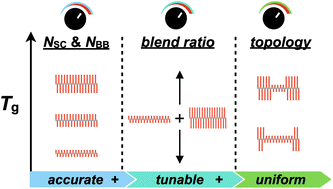Versatile strategies to tailor the glass transition temperatures of bottlebrush polymers†
Abstract
The glass transition of branched polymers is determined by multiple structural parameters that dictate their inter- and intramolecular interactions, and ultimately, their molecular packing in the amorphous phase. Here we examined the impact of side-chain length, backbone length, blend composition, and topology on the glass transition behavior of bottlebrush polymers. Through examining precision bottlebrush polymer libraries (PBP, ĐSC = 1.0), we find the infinite molecular weight Tg is reached at a specific brush length after which the effect of the side-chain length dominates. Being a factor more dominant than the backbone, side-chain length affects the Tg of bottlebrush polymers across all sizes and topology variations. To demonstrate the versatility of side chain engineering strategies, a broad range of Tg and glass transition behavior was targeted through judicious choice of side chain length, blend ratios, and brush topology. PBPs yield precise Tg with some values only accessible through making PBP blends at the cost of Tg broadening. Ultimately, multiblock PBPs combine the best features of both approaches; the ability to target arbitrary Tg while maintaining sharp glass transition.

- This article is part of the themed collection: Tailoring dispersity and shape of molecular weight contributions


 Please wait while we load your content...
Please wait while we load your content...